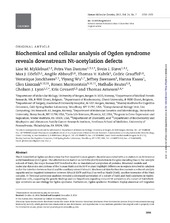| dc.contributor.author | Myklebust, Line Merethe | |
| dc.contributor.author | Van Damme, Petra | |
| dc.contributor.author | Støve, Svein Isungset | |
| dc.contributor.author | Dörfel, Max J | |
| dc.contributor.author | Abboud, Angèle | |
| dc.contributor.author | Kalvik, Thomas Vikestad | |
| dc.contributor.author | Grauffel, Cédric | |
| dc.contributor.author | Jonckheere, Veronique | |
| dc.contributor.author | Wu, Yiyang | |
| dc.contributor.author | Swensen, Jeffrey | |
| dc.contributor.author | Kaasa, Hanna | |
| dc.contributor.author | Liszczak, Glen | |
| dc.contributor.author | Marmorstein, Ronen | |
| dc.contributor.author | Reuter, Nathalie | |
| dc.contributor.author | Lyon, Gholson J | |
| dc.contributor.author | Gevaert, Kris | |
| dc.contributor.author | Arnesen, Thomas | |
| dc.date.accessioned | 2016-04-14T12:05:15Z | |
| dc.date.available | 2016-04-14T12:05:15Z | |
| dc.date.issued | 2014-12-03 | |
| dc.Published | Human Molecular Genetics 2015, 24(7):1956-1976 | eng |
| dc.identifier.issn | 1460-2083 | en_US |
| dc.identifier.uri | https://hdl.handle.net/1956/11908 | |
| dc.description.abstract | The X-linked lethal Ogden syndrome was the first reported human genetic disorder associated with a mutation in an N-terminal acetyltransferase (NAT) gene. The affected males harbor an Ser37Pro (S37P) mutation in the gene encoding Naa10, the catalytic subunit of NatA, the major human NAT involved in the co-translational acetylation of proteins. Structural models and molecular dynamics simulations of the human NatA and its S37P mutant highlight differences in regions involved in catalysis and at the interface between Naa10 and the auxiliary subunit hNaa15. Biochemical data further demonstrate a reduced catalytic capacity and an impaired interaction between hNaa10 S37P and Naa15 as well as Naa50 (NatE), another interactor of the NatA complex. N-Terminal acetylome analyses revealed a decreased acetylation of a subset of NatA and NatE substrates in Ogden syndrome cells, supporting the genetic findings and our hypothesis regarding reduced Nt-acetylation of a subset of NatA/NatE-type substrates as one etiology for Ogden syndrome. Furthermore, Ogden syndrome fibroblasts display abnormal cell migration and proliferation capacity, possibly linked to a perturbed retinoblastoma pathway. N-Terminal acetylation clearly plays a role in Ogden syndrome, thus revealing the in vivo importance of N-terminal acetylation in human physiology and disease. | en_US |
| dc.language.iso | eng | eng |
| dc.publisher | Oxford University Press | en_US |
| dc.rights | Attribution CC BY-NC | eng |
| dc.rights.uri | http://creativecommons.org/licenses/by-nc/4.0/ | eng |
| dc.title | Biochemical and cellular analysis of Ogden syndrome reveals downstream Nt-acetylation defects | en_US |
| dc.type | Peer reviewed | |
| dc.type | Journal article | |
| dc.date.updated | 2016-03-17T12:15:18Z | |
| dc.description.version | publishedVersion | en_US |
| dc.rights.holder | Copyright 2014 the authors | en_US |
| dc.identifier.doi | https://doi.org/10.1093/hmg/ddu611 | |
| dc.identifier.cristin | 1312345 | |
| dc.relation.project | Bergens forskningsstiftelse: xx | |
| dc.relation.project | Notur/NorStore: nn4700k | |

